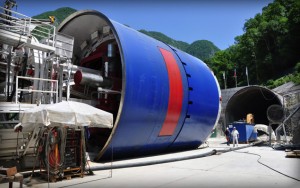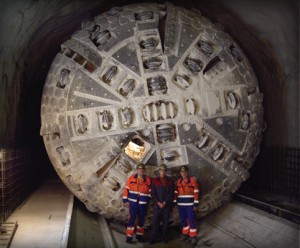![65 Years of Innovation and Experience [default]](https://www.robbinstbm.com/wp-content/uploads/2017/04/Side-Bar-Blue-Blocks_70-Years.jpg)
A Solution for Every Condition: Search our Project Database
Project Map
FEATURED PRODUCT: CROSSOVER MACHINES
Our History
A Legacy of Innovation
Information 24/7
News & Media
Insights in the Industry:
Read the Robbins Blog
 In 2012, the final of two Robbins Double Shield TBMs completed tunneling on schedule in Sochi, Russia in preparation for the host city’s 2014 Winter Olympic Games. In addition to the construction of the new Olympic park, water supply lines, power stations and arenas, the resort city wants to make sure that transportation isn’t a problem for its visitors. The transportation infrastructure project, commissioned by owner DCRC-Sochi, was divided into six complexes and will link road and railway routes between the small town of Adler on the Black Sea and the mountain resort of Alpika. The new lines will also connect to the M-27 highway, which travels along the Mzymta River through a national forest preserve with 46 bridges and 12 tunnels.
In 2012, the final of two Robbins Double Shield TBMs completed tunneling on schedule in Sochi, Russia in preparation for the host city’s 2014 Winter Olympic Games. In addition to the construction of the new Olympic park, water supply lines, power stations and arenas, the resort city wants to make sure that transportation isn’t a problem for its visitors. The transportation infrastructure project, commissioned by owner DCRC-Sochi, was divided into six complexes and will link road and railway routes between the small town of Adler on the Black Sea and the mountain resort of Alpika. The new lines will also connect to the M-27 highway, which travels along the Mzymta River through a national forest preserve with 46 bridges and 12 tunnels.
The entire project consists of 48.2 km (30 mi) of new road and railway lines, with a strict completion deadline of June 2013. In order to meet the schedule, excavation was performed in various ways, including using roadheaders, drill and blast equipment, and five TBMs.
Contractors OJSC Stroy-Trest and CSC Bamtunnelstroy ordered two refurbished TBMs to excavate parallel service and railway tunnels measuring 5.8 km (2.8 mi) and 4.6 km (2.9 mi), respectively. The rebuilt machines were selected to construct the tunnels due to their fast procurement time compared to new machines and the aggressive deadline of the project. A 10.0 m (32.8 ft) TBM was originally used on the Abdalajis rail tunnels in Spain between 2003 and 2006 and removed from storage for the Complex 3 tunnel. A 6.2 m (23.3 ft) Double Shield was originally built in 1993 for a hydroelectric project in Switzerland, and has since been used on multiple tunneling projects, totaling over 45 km (28 mi).
The 10.0 m (32.8 ft) machine was supplied for the Sochi project as rebuilt by a sub-contracted supplier, but several problems at start-up unveiled that some of the machine’s major components needed to be refurbished or replaced. After learning this, Bamtunnelstroy hired Robbins for on-site technical service and project consulting for Complex 3, as they were the original manufacturers of two of the three TBMs.
A crew of 15 from Robbins field service and engineering departments repaired and modified both TBMs. The 10.0 m (32.8 ft) machine received a new cutterhead support from Italy, while the main bearing was refurbished at a factory in Germany. In order to transport the 30 metric ton main bearing, the Antonov 124-100 aircraft was used, as it is the only one in existence that can carry these loads. The TBM also received upgrades to the lube system, cutterhead pressurization, and changes to the seal lubrication system. The 6.2 m (23.3 ft) Double Shield received new gear boxes and a PLC system. To make sure boring went smoothly, the Robbins crew stayed onsite until both machines were up and running.
The Robbins TBMs were specifically designed to excavate the fractured and faulted sedimentary geology that makes up the Sochi region. After testing the soil, it was determined that the machines would be boring mostly massive to completely fractured limestone with clay seams. Some sedimentary rock with sandstone and siltstone was also detected, as were fault zones made up of breccias and conglomerates.
Both machines were designed with a flat face, low profile muck buckets and radial scoops to optimize stabilization at the face of the tunnel. They were also equipped with replaceable bucket lips and injection ports, which allow foam additives to be injected into the soil through the cutterhead to treat the ground before and during boring.
 The 6.2 m (23.3 ft) TBM was launched in March 2010 in mixed ground. In May, however, the machine was stopped after it came across a fault zone consisting of broken rock and running soft ground. Field service crews were able to free the machine by hand excavating a timber bypass structure around the machine in front of the cutterhead, allowing debris to be removed. To evaluate the ground ahead, the crew drilled up to 62 m (203.4 ft) in front of the machine and found that the geology consisted of highly fractured ground. In order to accommodate the ground, polymer foam was injected in front of the machine to consolidate porphyry material around and in front of the cutterhead. The TBM was able to move forward without a problem once this was completed. To prevent a recurrence of the problem, crews performed continuous probe drilling during the remainder of the advance. When necessary, the ground was treated with cement silicate and foam to keep the machine moving steadily forward.
The 6.2 m (23.3 ft) TBM was launched in March 2010 in mixed ground. In May, however, the machine was stopped after it came across a fault zone consisting of broken rock and running soft ground. Field service crews were able to free the machine by hand excavating a timber bypass structure around the machine in front of the cutterhead, allowing debris to be removed. To evaluate the ground ahead, the crew drilled up to 62 m (203.4 ft) in front of the machine and found that the geology consisted of highly fractured ground. In order to accommodate the ground, polymer foam was injected in front of the machine to consolidate porphyry material around and in front of the cutterhead. The TBM was able to move forward without a problem once this was completed. To prevent a recurrence of the problem, crews performed continuous probe drilling during the remainder of the advance. When necessary, the ground was treated with cement silicate and foam to keep the machine moving steadily forward.
Despite its challenges, the 6.2 m (23.3 ft) TBM experienced good advance rates of 100 to 120 m (328.1 ft to 393.7 ft) per week, and 14 m (46 ft) per day. The machine achieved breakthrough at the service tunnel on March 2, 2011. After completion, the machine was disassembled and is now being stored near the city of Novorossiysk. It is expected to be used for future tunneling projects, as it is in good shape and experienced very low cutter wear during its bore on Complex 3.
The 10.0 m (32.8 ft) Double Shield was launched in September 2010 and excavated effectively through fault zones 25 and 50 m (82.0 and 164.0 ft) wide, consisting of highly weathered material have been excavated so far, using probe drilling and pre-grouting to consolidate the rock. The massive machine completed its excavation in 2012, breaking through on February 14.

 Close
Close